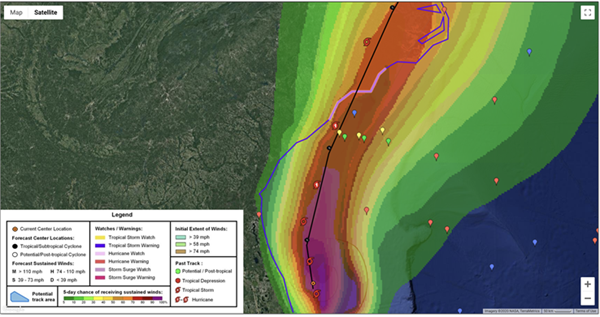NOAA’s Efforts to Improve Hurricane Forecasts Tested on Isaias
with Gliders, Drifters, and Argo floats
 NOAA’s Extreme Events-Ocean Observations (EE-OO) Task Team supports the coordination of targeted and sustained ocean observing efforts to improve the understanding of air-sea interaction during high wind events, with the goal of improving the accuracy of hurricane intensity forecasts. The task team coordinated observations in front of and along the track of Hurricane Isaias with air deployed drifters and already in place Argo floats and gliders, and are now conducting analysis of data and potential ocean impacts.
NOAA’s Extreme Events-Ocean Observations (EE-OO) Task Team supports the coordination of targeted and sustained ocean observing efforts to improve the understanding of air-sea interaction during high wind events, with the goal of improving the accuracy of hurricane intensity forecasts. The task team coordinated observations in front of and along the track of Hurricane Isaias with air deployed drifters and already in place Argo floats and gliders, and are now conducting analysis of data and potential ocean impacts.
Highlights:
Hurricane Isaias provided a test case to evaluate the ocean component of the full end-to-end hurricane forecast data flow across three regions: the formation zone in the Caribbean, the re-intensification zone just before landfall in the South Atlantic Bight, and an impact zone in the Mid Atlantic Bight.
The Navy’s data-assimilative Global Ocean Forecast System (GOFS) – the start of the ocean forecast value chain for hurricanes – demonstrated that a global model can reproduce key Essential Ocean Features across all three regions through the assimilation of temperature and salinity profile data from the combined Argo plus Hurricane Glider network.
As of August 4, 2020, Hurricane Weather Research and Forecast System (HWRF), one of the world’s leading hurricane forecast models, officially switched to the same ocean initial condition value chain for the ocean component of its coupled atmosphere-ocean forecasts. This will enable realistic, data supported representation of the ocean in regions of hurricane generation and development.
This effort is made possible with a team of scientists and researchers from AOML, Scripps Institution of Oceanography, Rutgers University, WHOI, University of Miami, and support from GOMO, US IOOS, and NWS. This team worked safely during the COVID-19 pandemic, following CDC and NOAA guidelines, to deploy for the third year an enhanced Hurricane Glider Picket Line to conduct ocean observations that are used in hurricane forecast models with the
ultimate goal of protecting life and property in U.S. coastal areas.
 See attached PDF for more information.
See attached PDF for more information.